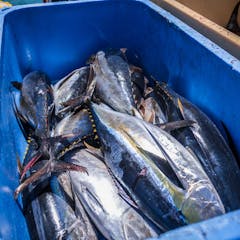
Articles on Fish farming
Displaying 1 - 20 of 38 articles

As we go from fishing to fish farming, we should borrow restorative approaches from permaculture.

Breeding tuna in captivity is a promising solution to overfishing, but there are concerns surrounding fish welfare.

Ecolabelled seafood fetches higher prices in supermarkets, giving retailers and producers the incentive to up their sustainability game.

Consumers are increasingly concerned about the sustainability of their fish.

Combining aquaculture and hydroponics, aquaponics unearths value in “waste” flows and re-routes them back into the economy. It’s an inspiring example of how a circular-economy business model can work.

Growing demand for large salt-water clams is leaving parts of the B.C. coast littered with plastic debris.

A new IPCC report has called for radical changes in food production to avoid catastrophic climate change. Rice-fish farming and mixed crops could help.

Scientists are predicting major algae blooms in Lake Erie and large dead zones in the Chesapeake Bay and Gulf of Mexico this summer. Nutrient pollution from industrial corn farming is a major driver.

Fish farming has been criticised for a lack of sustainability – here’s what has been changing and what still remains a challenge.

Feeding pigs seaweed could make them, us and the planet healthier without contributing to antibiotic resistance in bacteria.

With proper regulation, Lake Victoria’s fisheries could increase production without damaging wild stocks or the environment.

We need to change how we produce, ship, eat and waste food to improve our health and that of the planet.

For the most nutritious and sustainable seafood option, try small ocean fish.

Many people focus just on agriculture and new technologies for feeding the world’s growing population. Yet, fisheries are the centerpiece of billions of people’s diets.

Aquaculture is endangering the marine environment, threatening the livelihood of small-scale fishers and food security.

A recent summit in Ottawa on what’s known as agroecology has shown that more equitable and sustainable methods of producing food are not only possible, they’re beginning to spread around the world.

Food systems must be transformed to produce more nutritious food with a lower environmental footprint.

The seafood industry is a major contributor to modern slavery.

This is a critical time for our planet. What we eat and how we get our food will shape its future.

Salmon prices are soaring because of sea lice infestations – but new medicine and technology could help.
